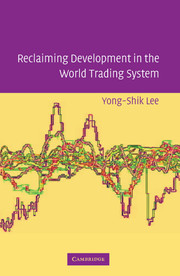Book contents
- Frontmatter
- Contents
- List of Abbreviations
- Acknowledgments
- 1 Poverty, Economic Development, and International Trade
- 2 Current Regulatory Framework for International Trade: The WTO System
- 3 Reclaiming Development: Tariff Bindings and Subsidies
- 4 Anti-Dumping and Safeguards
- 5 “Expansion” of Trade Disciplines and Development
- 6 Foreign Direct Investment and Regional Trade Liberalization
- 7 Conclusion: Putting Back the Ladder
- Epilogue
- Bibliography
- Index
2 - Current Regulatory Framework for International Trade: The WTO System
Published online by Cambridge University Press: 18 August 2009
- Frontmatter
- Contents
- List of Abbreviations
- Acknowledgments
- 1 Poverty, Economic Development, and International Trade
- 2 Current Regulatory Framework for International Trade: The WTO System
- 3 Reclaiming Development: Tariff Bindings and Subsidies
- 4 Anti-Dumping and Safeguards
- 5 “Expansion” of Trade Disciplines and Development
- 6 Foreign Direct Investment and Regional Trade Liberalization
- 7 Conclusion: Putting Back the Ladder
- Epilogue
- Bibliography
- Index
Summary
Introduction
Historical Background
As discussed in Chapter 1, the regulatory framework for international trade should allow developing countries to adopt effective development policies. This chapter introduces the current regulatory framework for international trade, represented by the WTO, with a brief account of its historical development. The current trading system includes provisions to facilitate development, and these provisions are also discussed in this chapter. Later chapters analyze the current provisions and conclude that they are not adequate to facilitate development of developing economies. This inadequacy leads us to consider alternative provisions that would better serve the development needs of developing countries.
A multilateral regulatory framework for international trade was first contemplated at the Bretton Woods Conference during the Second World War. Trade protectionism that was prevalent during the 1930s led to exclusive trade blocs and was an important cause of this tragic war. Lessons were learned from this experience, and efforts were made to create a new trading system that would promote open trade so that arbitrary trade restrictions and exclusions would not cause yet another major conflict. The Charter for the International Trade Organization (ITO) was drawn up after the war with an objective of establishing a new trading system. However, political support for the creation of the new trading system began to quickly wane after the war, and the United States failed to ratify the ITO because of congressional objection. Without the participation of the United States, the ITO could not come into existence.
- Type
- Chapter
- Information
- Reclaiming Development in the World Trading System , pp. 14 - 48Publisher: Cambridge University PressPrint publication year: 2006



